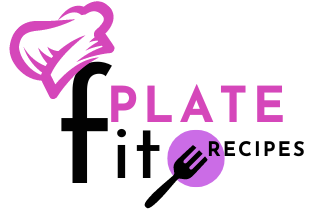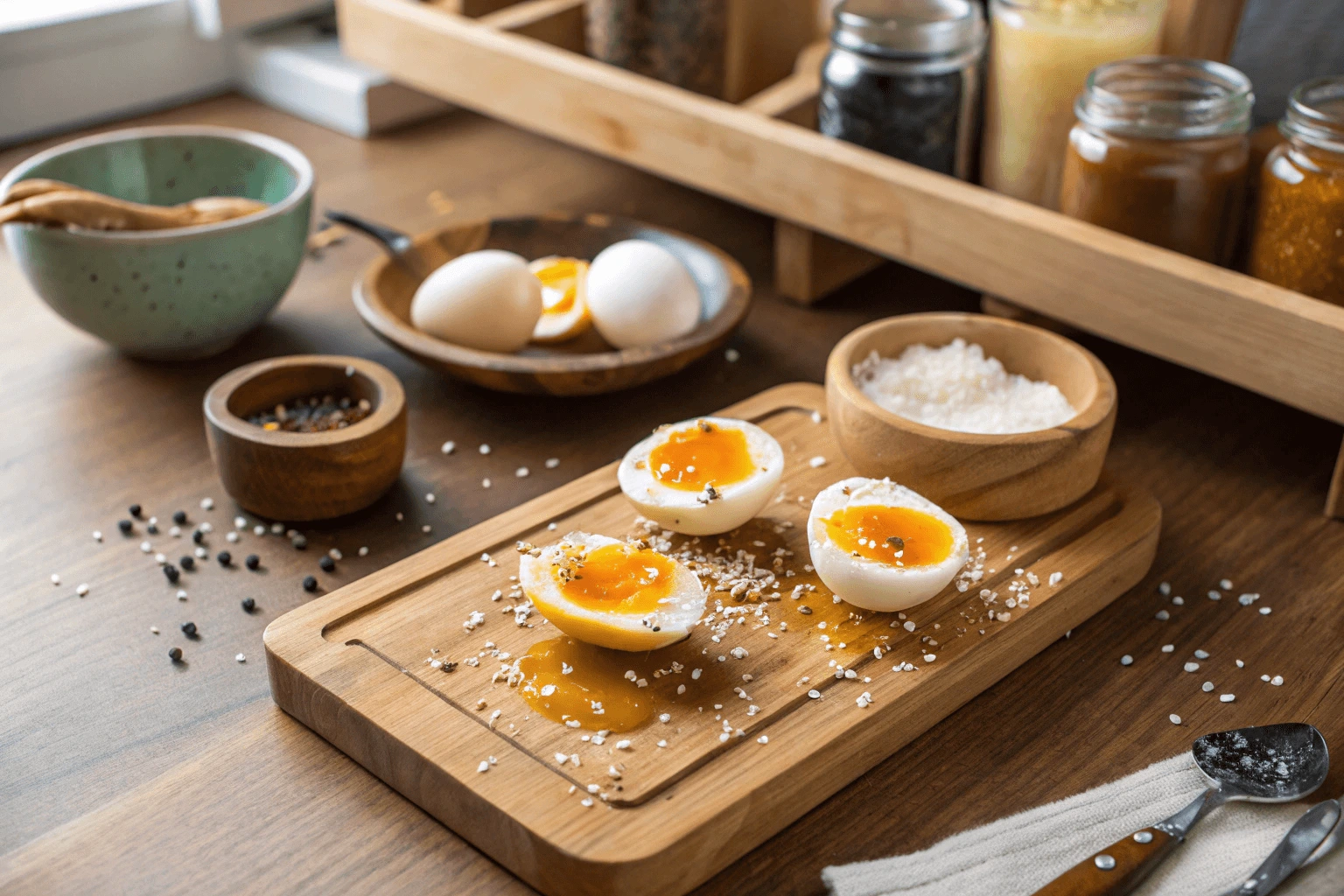Introduction
Soft-boiled eggs with a jammy, golden yolk and firm yet tender whites are a simple pleasure. Whether you’re adding them to ramen, tossing them into a salad, or just enjoying them with toast, jammy eggs make every meal better. But let’s be honest—getting that perfect consistency isn’t always easy.
How long should you boil eggs to be jammy? What’s the difference between a 5-minute egg and a 7-minute egg? Do you really need an ice bath to get that dreamy texture?
This guide will answer all your questions and walk you through a foolproof jammy eggs recipe that works every single time. You’ll also learn the best ways to serve, store, and troubleshoot these eggs, so let’s crack into it!
CONTENTS
Table of Contents
Why Jammy Eggs Are a Game-Changer for Every Meal
The Secret to the Perfect Soft-Boiled Egg
At first glance, a jammy egg might just seem like a soft-boiled egg with a slightly firmer center—but there’s more to it than that. The perfect jammy egg has a thick, creamy yolk, not runny but not solid either. It’s that magical sweet spot between a hard-boiled and a soft-boiled egg, making it incredibly versatile.
So, what’s the secret? Timing, temperature, and cooling. Unlike hard-boiled eggs, which can sit in hot water for a while without much change, jammy eggs need precise timing—boil them too long, and the yolk becomes crumbly; too short, and they’re too runny. And don’t skip the ice bath—it stops the cooking process immediately, giving you that perfect consistency.
How Jammy Eggs Add Flavor and Texture to Any Dish
These eggs aren’t just about looks. Their gooey, golden center adds richness and creaminess to dishes without extra ingredients. Here are a few ways to enjoy them:
- In ramen: The yolk melts into the broth, adding depth and creaminess.
- On avocado toast: A simple upgrade that brings protein and a silky texture.
- With salads: The soft yolk creates a natural dressing when mixed with greens.
- On rice bowls: Adds flavor and richness, making plain rice feel gourmet.
Because of their mild, slightly buttery taste, jammy eggs also pair well with seasonings like soy sauce, sesame oil, or even a pinch of chili flakes. Whether you’re looking for a quick breakfast, a protein-packed snack, or an easy topping for your meal, these eggs do it all.
What Are Jammy Eggs? Everything You Need to Know
The Science Behind That Gooey Yolk
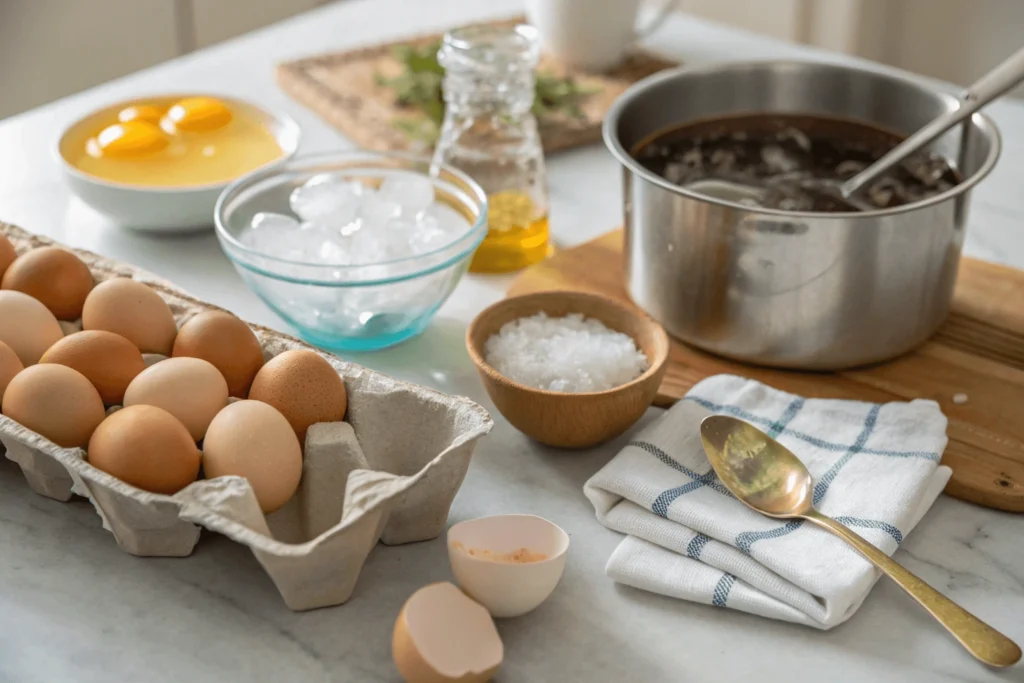
A jammy egg is a soft-boiled egg with a thick, creamy yolk that holds its shape but still has a luscious, spreadable texture. Unlike runny eggs, which spill the moment you slice into them, jammy eggs are firm enough to cut but still ooze slightly when pressed.
The secret to achieving this texture lies in timing and temperature. Egg yolks begin to set at around 145°F (63°C), but to get that jammy consistency, they need to reach 155–160°F (68–71°C). The trick is boiling the eggs just long enough to cook the whites completely while leaving the yolk soft and custardy.
Many people ask, How long should you boil an egg for it to be gooey? The ideal time for a jammy egg is 6 to 7 minutes in boiling water, followed by an immediate ice bath to stop the cooking process.
Jammy Eggs vs. Soft-Boiled vs. Hard-Boiled: What’s the Difference?
Not all boiled eggs are the same. Here’s how jammy eggs compare to other styles:
- Soft-Boiled Eggs (4–5 minutes) – The whites are barely set, and the yolk is completely runny. These are perfect for dipping toast soldiers but can be tricky to peel.
- Jammy Eggs (6–7 minutes) – The whites are fully set, but the yolk is thick and spreadable. These are great for ramen, salads, and grain bowls.
- Hard-Boiled Eggs (9–12 minutes) – The yolk is fully firm, with a pale yellow color. These are best for deviled eggs, egg salad, or snacking.
Many people confuse jammy eggs with a 5-minute egg, but they’re not quite the same. What is a 5-minute egg? It’s a soft-boiled egg with a much runnier yolk, closer to a poached egg in texture.
How to Make Jammy Eggs at Home – Step-by-Step
The Best Cooking Method for Perfect Results
If you’ve ever struggled with overcooked or undercooked eggs, this foolproof jammy eggs recipe will change everything. Follow these simple steps:
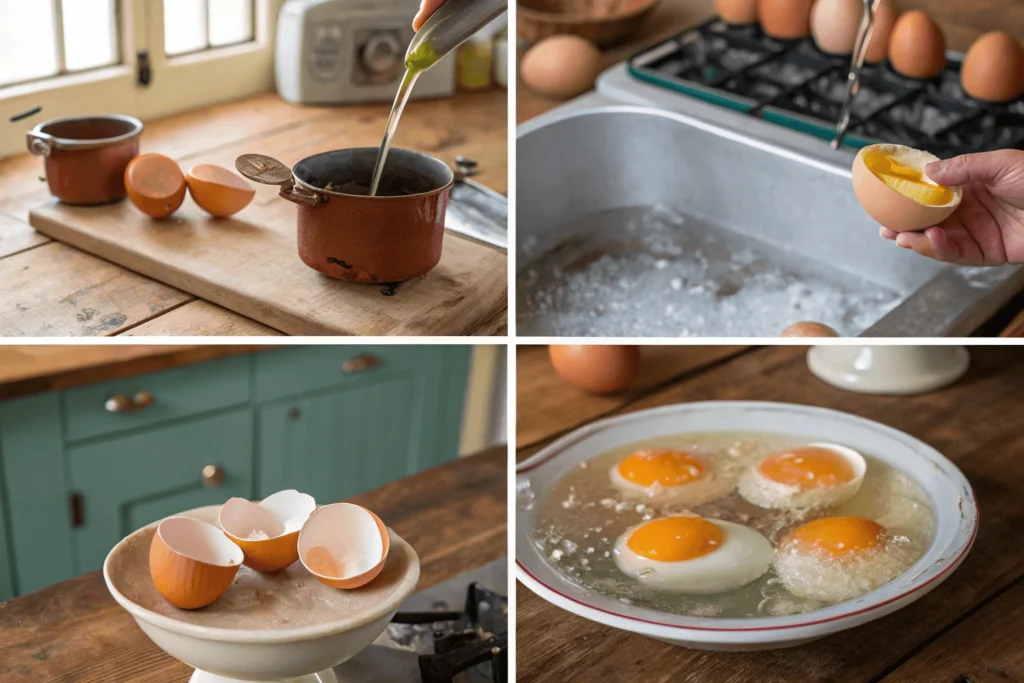
Ingredients:
- Large eggs (as many as you need)
- Water (enough to fully cover the eggs)
- Ice (for the ice bath)
- Salt (optional, to help with peeling)
Instructions:
- Boil the Water – Fill a pot with water and bring it to a rolling boil. Make sure there’s enough water to fully submerge the eggs.
- Gently Add the Eggs – Use a spoon to lower the eggs into the water to prevent cracking.
- Set the Timer – Boil for exactly 6 to 7 minutes, depending on how gooey you want the yolk.
- Prepare an Ice Bath – While the eggs are boiling, fill a bowl with ice water.
- Shock the Eggs – Once the timer goes off, immediately transfer the eggs to the ice bath. Let them sit for at least 5 minutes to stop the cooking.
- Peel and Enjoy – Gently tap the eggshells, roll them on a hard surface, and peel under running water for easy removal.
Water Temperature, Timing, and Cooling: Why They Matter
Many people ask, How long to boil eggs to be jammy? The key is consistency. Boiling for 6 minutes will give you a slightly runny yolk, while 7 minutes creates a thicker, more jammy texture.
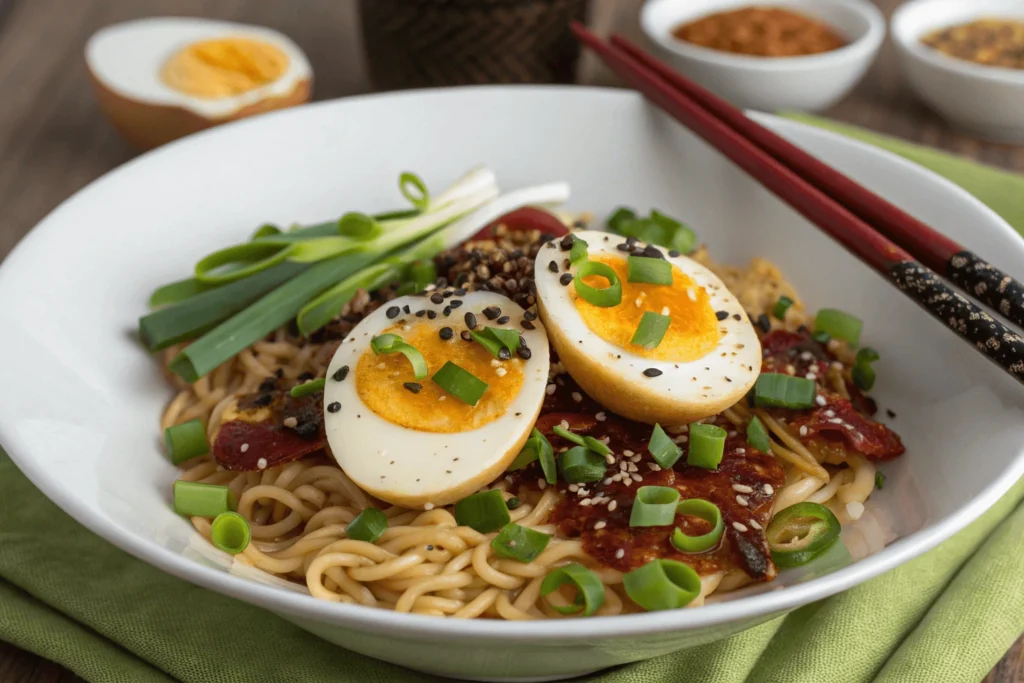
The ice bath is just as important as the boiling step. Without it, the eggs continue to cook in their shells, leading to overcooked yolks. Always transfer them straight to ice water for that perfect texture.
How Long to Boil Eggs for the Ideal Jammy Yolk?
Timing Guide: 5, 6, 7, and 8-Minute Eggs Explained
Getting the perfect jammy eggs recipe comes down to precise timing. Even one extra minute in boiling water can change the yolk’s consistency. Here’s a quick breakdown of boiling times and how they affect your eggs:
- 5-minute eggs – The whites are just set, and the yolk is very runny, almost like a poached egg.
- 6-minute eggs – Whites are fully set, while the yolk is thick and gooey but still slightly runny.
- 7-minute eggs – The ideal jammy eggs recipe—yolks are custardy and hold their shape, perfect for slicing.
- 8-minute eggs – The yolk starts to firm up but still has a creamy center.
A common question is, How long should you boil an egg for it to be gooey? The best range is 6 to 7 minutes, depending on how thick you want the yolk.
Why an Ice Bath Is the Key to the Perfect Texture
Once the eggs reach the perfect doneness, don’t just drain the hot water and let them sit—transfer them immediately into an ice bath. This step stops them from overcooking, keeping the yolk at that jammy consistency. Without it, the eggs will continue cooking inside their shells, leading to a firmer, more crumbly yolk.
The ice bath also helps with peeling. The sudden temperature change causes the egg whites to contract slightly, pulling away from the shell. This makes peeling much easier, preventing frustration and wasted egg whites.
Tips to Get Jammy Eggs Right Every Time
Common Mistakes That Ruin Soft-Boiled Eggs
Even though making jammy eggs sounds simple, a few mistakes can throw off your results:
- Starting with cold water – Always add eggs to boiling water. Cold starts make timing unpredictable and can lead to uneven cooking.
- Skipping the ice bath – Without it, your yolks won’t stay jammy. They’ll keep cooking even after you remove them from the water.
- Overcrowding the pot – Too many eggs at once can lower the water temperature, messing up your timing.
- Not setting a timer – A jammy yolk is all about precision. Even a 30-second difference can change the texture.
How to Easily Peel Soft-Boiled Eggs Without a Mess
Peeling jammy eggs can be tricky, but these tips make it easier:
- Crack the shell gently – Tap the egg on a hard surface and roll it lightly to create small cracks all over.
- Peel under running water – This helps slide the shell off smoothly without damaging the egg white.
- Use older eggs – Fresh eggs are harder to peel. If possible, use eggs that are at least a week old.
- Shake in a jar – Place eggs in a container with a little water, seal, and shake gently. This loosens the shell quickly.
Jammy Eggs Variations – Unique Flavors to Try
Soy Sauce-Marinated Jammy Eggs
If you’ve ever had ramen at a good Japanese restaurant, you’ve probably seen ajitsuke tamago, or soy-marinated eggs. This variation takes a simple jammy eggs recipe and adds a rich, savory kick.
How to Make It:
- Make a batch of 7-minute eggs and peel them.
- In a bowl, mix ½ cup soy sauce, ½ cup water, 1 tbsp sugar, and 1 tbsp rice vinegar.
- Submerge the eggs in the marinade and refrigerate for at least 4 hours (or overnight for deeper flavor).
- Slice and enjoy in ramen, rice bowls, or on their own!
These eggs soak up the umami-rich marinade, making them a must-try. If you’ve ever wondered, what are 7-minute eggs?, they’re the perfect base for this recipe—firm enough to hold together, yet gooey inside.
Spicy, Herbed, or Sesame-Flavored Jammy Eggs
For a unique twist, try seasoning your jammy eggs after peeling. Here are some quick ideas:
- Spicy: Drizzle with chili oil or sprinkle with red pepper flakes for a kick.
- Herbed: Chop fresh chives, dill, or parsley and toss them with your eggs.
- Sesame: Drizzle with toasted sesame oil and top with sesame seeds for a nutty flavor.
For those who ask, how long should you boil an egg for it to be gooey?—stick to 6-7 minutes before adding flavors. This keeps the yolk creamy enough to absorb seasonings without turning dry.
Best Ways to Serve Jammy Eggs
Breakfast, Lunch, and Dinner: How to Pair Jammy Eggs
The beauty of a jammy eggs recipe is how easily it fits into any meal. Whether you’re craving a protein-packed breakfast, a light lunch, or a filling dinner, these eggs work perfectly.
- For breakfast: Serve on avocado toast or alongside crispy bacon and buttered toast.
- For lunch: Add to a grain bowl with quinoa, roasted veggies, and a drizzle of tahini.
- For dinner: Drop into a hot bowl of ramen or serve with steak and mashed potatoes.
A 5-minute egg is great for dipping toast, but a jammy egg is better for slicing into meals. If you want a gooey texture that holds its shape, go with a 7-minute egg instead.
Adding Jammy Eggs to Ramen, Salads, and Avocado Toast
Jammy eggs shine in dishes that need a rich, creamy element. Here’s how to use them:
- Ramen: The yolk blends into the broth, making it extra flavorful.
- Salads: Slice eggs over Caesar salad or arugula with lemon dressing.
- Avocado toast: Mash avocado, top with a sliced egg, and sprinkle with flaky salt.
Jammy Eggs for Meal Prep – How to Store and Use Them
How Long Do Jammy Eggs Last in the Fridge?
If you’re making a batch of jammy eggs ahead of time, proper storage is key. These eggs can last up to 4 days in the refrigerator, but they need to be stored correctly to keep their gooey yolks from drying out.
- Unpeeled jammy eggs: Store them in their shells in an airtight container. This keeps them fresh longer and prevents them from absorbing fridge odors.
- Peeled jammy eggs: Place them in a sealed container with a damp paper towel to keep them from drying out.
Many people wonder, how long should you boil an egg for it to be gooey? The answer depends on preference, but for meal prep, sticking to 7-minute eggs is best. They hold their texture well and don’t become too firm after chilling.
How to Reheat or Use Cold Jammy Eggs
Unlike hard-boiled eggs, jammy eggs don’t reheat well in the microwave—they can overcook quickly. Instead, try these methods:
- Warm water soak: Place the eggs (in their shells) in warm water for 2–3 minutes to gently bring them to room temperature.
- Eat them cold: Jammy eggs taste great straight from the fridge, especially when added to salads, grain bowls, or avocado toast.
If you’re wondering, what are 7-minute eggs?—they’re the perfect texture for meal prep because they stay creamy even after refrigeration.
Troubleshooting – Fixing Common Jammy Egg Issues
Why Are My Jammy Eggs Too Runny or Too Firm?
Timing is everything when making a jammy eggs recipe. If your eggs aren’t turning out the way you want, here’s what might be going wrong:
- Too runny? You probably boiled them for less than 6 minutes. Try keeping them in the water for 6.5 to 7 minutes for a thicker consistency.
- Too firm? This means they were in the boiling water too long. Stick to the 6–7 minute range and always use an ice bath to stop cooking immediately.
A common question is, how long to boil eggs to be jammy? The best time is 6–7 minutes, followed by a quick transfer to ice water.
What to Do If the Shells Won’t Peel Cleanly
Peeling jammy eggs can sometimes be frustrating. Here are a few tricks to make it easier:
- Use older eggs: Fresh eggs have membranes that stick tightly to the shell, making them harder to peel. Eggs that are at least a week old work best.
- Crack and roll: Gently tap the shell on a hard surface and roll it under your palm to create cracks all over.
- Peel under running water: Cold water helps separate the shell from the egg white.
Many people confuse jammy eggs with a 5-minute egg, but they’re not the same. What is a 5-minute egg? It’s much softer, with a very runny yolk, while jammy eggs have a thicker, spreadable center.
Print
How to Make Jammy Eggs – Foolproof 7-Minute Soft-Boiled Eggs
- Total Time: 12 minutes
Description
This jammy eggs recipe gives you perfectly soft-boiled eggs with creamy, gooey yolks and firm whites. Perfect for ramen, salads, or toast, these 7-minute eggs are easy to make and add richness to any dish. Follow this foolproof method for consistent results every time!
Ingredients
- 6 large eggs
- Water (enough to fully submerge eggs)
- Ice cubes (for an ice bath)
- 1 teaspoon salt (optional, helps with peeling)
Instructions
- Boil the water: Bring a pot of water to a rolling boil over medium-high heat.
- Add the eggs: Gently lower the eggs into the boiling water using a spoon.
- Set the timer: Boil the eggs for exactly 6 to 7 minutes depending on how gooey you want the yolk.
- Prepare an ice bath: While the eggs are boiling, fill a large bowl with ice and cold water.
- Cool the eggs: Once the timer goes off, immediately transfer the eggs to the ice bath. Let them sit for 5 minutes to stop the cooking process.
- Peel and serve: Tap the eggs gently on a hard surface, roll them slightly, and peel under running water for easy removal. Slice and enjoy!
Notes
- How long should you boil an egg for it to be gooey? 6 to 7 minutes is the perfect range for a jammy yolk.
- Want easier peeling? Use slightly older eggs (at least a week old) for best results.
- For extra flavor, try marinating the eggs in soy sauce, rice vinegar, and a touch of sugar for 4–6 hours.
- Prep Time: 5 minutes
- Cook Time: 7 minutes
